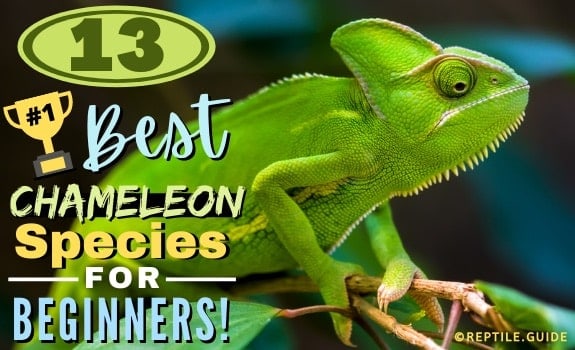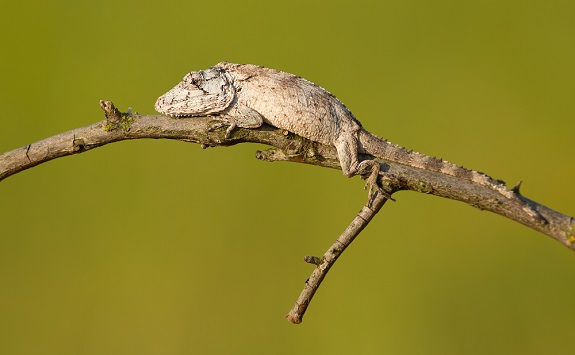Chameleons certainly make interesting and peculiar little pets. With their independently moving eyes, lightning-fast long tongue, and ever-changing coloration, they’re fascinating, to say the least.
But, did you know that there are several different species of Chameleon you can choose from in captivity?
In general, Chameleons are rather sensitive animals that don’t tolerate handling or husbandry mistakes very well. With that said, they’re fun to watch, full of personality, and attractive animals that enjoy living in beautiful, planted habitats.
There are also certainly some species of Chameleon that are better for rookies than others.
Most Chameleon veterans recommend Veiled Chameleons or Panther Chameleons to beginners, with Carpet Chameleons being a close runner-up.
However, your skill level, commitment, and interests may draw you towards something a little more rare, exotic, and challenging…
And that’s perfectly fine! In that case, we’ve included several other elusive species that can occasionally be found for sale.
Finally, we included a particular “bonus” species at the end that’s perfect for both rookies and seasoned collectors alike.
Curious what the BEST pet Chameleon species is for YOU? Just keep reading!
In This Article
1. Veiled Chameleon
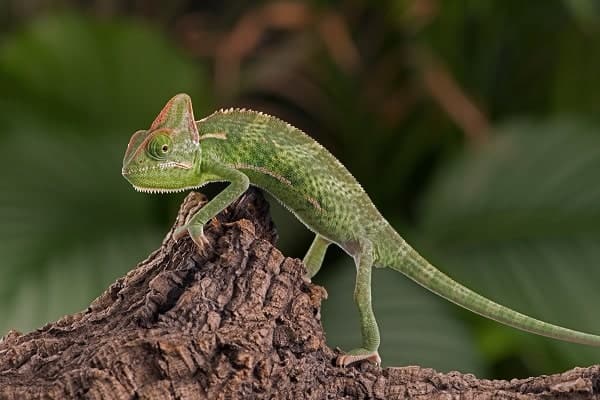
When it comes to beginner-friendly chameleon species, Veiled Chameleons really take the cake. This popular species is native to the Arabian Peninsula, which is why it’s also known as the Yemen Chameleon.
They’re recommended, time and again, as anyone’s first pet chameleon.
Veiled Chameleons readily breed in captivity, and captive-bred animals are healthier and hardier. They’re typically free of parasites and already acclimated to life in an enclosure.
Captive-bred baby Veiled Chameleons usually cost around $50 or more. However, beginners are advised to purchase adult animals since they’re less sensitive.
These attractive chameleons are typically green, with males featuring stunning, defined black, yellow, white, and orange bands. Females are also relatively colorful, but they take on more of a mottled appearance.
Both males and females have casques, after which they’re named, but the casque is more pronounced on mature males. They grow to be 12-24 inches long.
If well cared for, Veiled Chameleons live for 4-8 years.
Veiled Chameleons need a well-ventilated, large enclosure with an 80-85°F basking spot and 50-65% humidity. The MINIMUM enclosure size for a single adult is 2’ x 2’ x 4’.
Their enclosure should be misted twice a day for two minutes at a time.
| Species Summary | |
|---|---|
| Scientific Name | Chamaeleo calyptratus |
| Common Name | Veiled Chameleon, Yemen Chameleon |
| Lifespan | 4-8 years |
| Size | 12-24 inches long |
| Price | Around $50 |
| Enclosure Size | Minimum 2′ L x 2′ W x 4′ H |
| Skill Level Required | Beginner |
2. Panther Chameleon
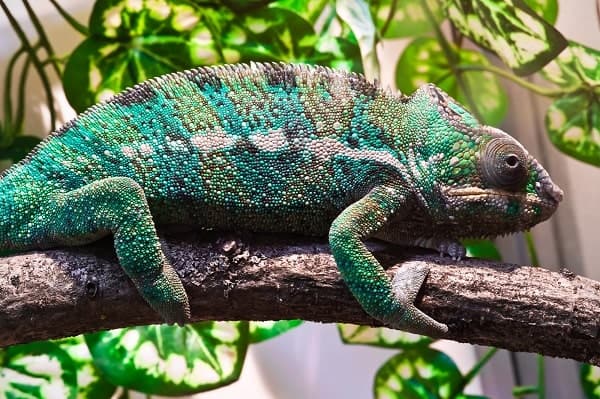
Panther Chameleons are also often recommended to beginners. They’re slightly more expensive, ranging from $150 on up.
Most Panther Chameleons on the market are captive-bred, as well. However, they originate from the northern and eastern parts of Madagascar.
Breeders are working on several different localities of Panther Chameleons. For instance, Nosy Be Panther Chameleons tend to be mostly blue. Amilobe Panther Chameleons usually display higher levels of red coloration.
There are numerous other localities available, and the color variances even in the same strain of animals can be striking.
Depending on the locality, the males of these attractive lizards are either predominantly red, blue, green, or orange.
Females tend to remain mostly brown and tan with some colorful patterning. This is a large chameleon, with females reaching an average length of 9-13 inches and males attaining a length of 14-21 inches.
Well-cared-for Panther Chameleons have an average lifespan of 5-7 years, which you can enjoy when raising them as babies. They’re said to be one of the more docile and friendly chameleon species.
Panther Chameleons require large, well-ventilated enclosures with a 90-95°F basking spot and 40-60% humidity. The enclosure should be at least 1.5′ x 1.5′ x 3′.
This high-humidity species requires 2-3 mistings per day.
| Species Summary | |
|---|---|
| Scientific Name | Furcifer pardalis |
| Common Name | Panther Chameleons |
| Lifespan | 5-7 years |
| Size | 9-13 inches |
| Price | $150+ |
| Enclosure Size | Minimum 1.5′ L x 1.5′ W x 3′ T |
| Skill Level Required | Beginner |
3. Carpet Chameleon

Carpet Chameleons are a lesser-known species of Chameleon that’s said to be easy to care for in captivity. They hail from the jungles of Madagascar. Babies sell for $125 to $200.
Carpet Chameleons start the morning mostly black with hints of vibrant pattern and color. This coloration is used to absorb a lot of heat quickly.
By mid-day, after they’ve warmed up, they’re intensely embellished with rosettes, stripes, and bands of green, blue, red, orange, and yellow.
They’re so intricately designed that they were named after oriental carpets!
Unlike most other chameleons, female Carpet Chameleons are more intensely colored and patterned than their male counterparts. Some claim that they’re one of the most vibrantly colored species bred in captivity.
This is a small species; they attain lengths from 6.5 to 10 inches. Again breaching the Chameleon norm, adult males and females are usually the same size.
Carpet Chameleons have a relatively short lifespan of 2 to 3 years if well-cared for.
They thrive in a small, well-planted enclosure with a 90-95°F basking spot and 50-60% humidity. A single adult can thrive in a screen enclosure that’s 1′ x 1′ x 2′.
| Species Summary | |
|---|---|
| Scientific Name | Furcifer lateralis |
| Common Name | Carpet Chameleons |
| Lifespan | 2-3 years |
| Size | 6.5-10 inches |
| Price | $125-$200 |
| Enclosure Size | Minimum 1′ L x 1′ W x 2′ T |
| Skill Level Required | Beginner |
4. Jackson’s Chameleon
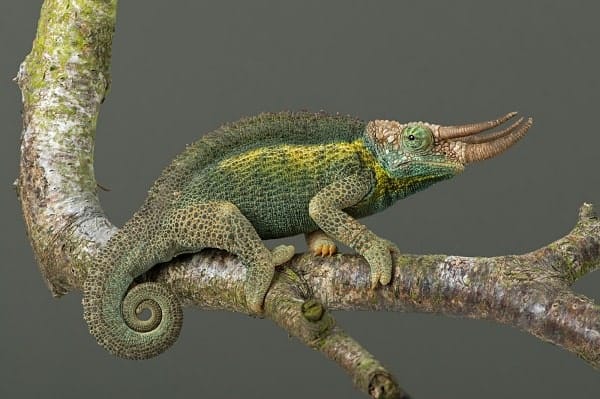
Jackson’s Chameleons are known for being particularly sensitive to husbandry mistakes, but they’re still popular in captivity thanks to their vivid coloration and the triceratops-like horns of males.
Females have no horns or have little vestigial nubs of horns.
Captive-bred babies are easy to find, costing around $80 to $150 per animal.
This species is native to East Africa, with established invasive populations in Hawaii, California, and Florida.
They’re typically bright green with traces of blue and yellow. Growing from 8 to 12 inches long, they’re a medium-size species of Chameleon.
Males have a relatively long lifespan of 8-10 years, but female Jackson’s Chameleons still only live for 4-5 years.
Jackson’s Chameleons require moderately-sized, well-ventilated enclosures with an 82-85°F basking spot and 50-80% humidity.
Temperatures above 85°F are detrimental to their health, and this species will NOT thrive without a night-time temperature drop to 50-59°F. A 2′ x 2′ x 3′ enclosure will comfortably house a single adult Jackson’s Chameleon.
Mist the enclosure until every surface is wet AT LEAST twice a day.
⭐️ Fun Fact: One surprising fact about Jackson’s Chameleons is that, instead of laying eggs like most chameleons, mothers give live birth to 8 to 30 babies!
| Species Summary | |
|---|---|
| Scientific Name | Trioceros jacksonii |
| Common Name | Jackson’s Chameleons |
| Lifespan | 4-5 years |
| Size | 8-12 inches |
| Price | $80-$150 |
| Enclosure Size | 2′ W x 2′ L x 3′ T |
| Skill Level Required | Intermediate |
5. Parson’s Chameleon
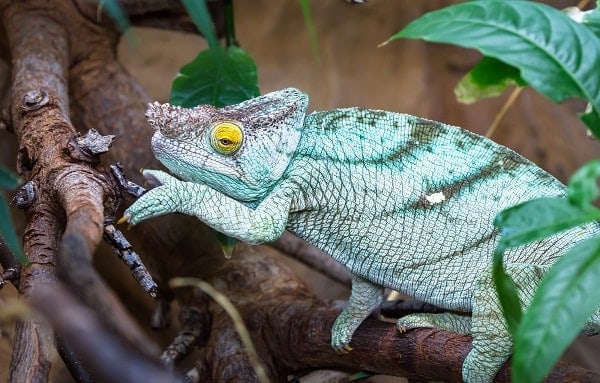
Parson’s Chameleons are considered the heaviest of the true chameleons, but not the longest, reaching lengths of 18-28 inches but often weighing over 700 grams. They’re native to northeast Madagascar.
Due to their rarity, captive-bred babies start at $200 and range up to $1,000 established adults!
They’re somewhat hardy in captivity in terms of humidity and temperature, and although they’re large, they’re inactive, so they don’t require an incredibly expansive enclosure.
Males are green or turquoise, while females are green, yellow, or brown. Males also have two warty ridges running from their eyes to their noses.
There are several recognized morphs, or localities, known as “orange-eyed” or “white-lipped,” “yellow lip,” “yellow giant,” and “green giant.”
Parson’s Chameleons require a large, well-ventilated enclosure with an 85-88°F basking spot and 30-70% humidity. The enclosure should be at least 4’ x 2’ x 4’.
Be mindful that this species requires more water than any other species, best provided by offering at least 2-3 showers or mistings every day. These shower or misting sessions should last 30 to 60 minutes.
In addition to their high water requirements, Parson’s Chameleons are notoriously picky and sometimes stop eating certain feeders out of boredom.
Access to a variety of insects is VITAL for keeping this species.
| Species Summary | |
|---|---|
| Scientific Name | Calumma parsonii |
| Common Name | Parson’s Chameleon |
| Lifespan | 12-15+ years |
| Size | 18-28 inches |
| Price | $200-$1,000 |
| Enclosure Size | Minimum 4’ W x 2’ L x 4’ T |
| Skill Level Required | Intermediate |
6. Dwarf Fischer’s Chameleon
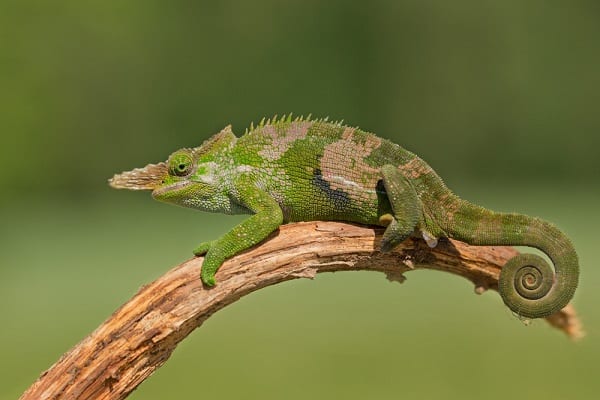
Dwarf Fischer’s Chameleons are a rather drab-colored chameleon that is rare in captivity. They’re native to Kenya and Tanzania.
Captive-bred animals are hard to find, but imported individuals can be purchased for less than $100.
Both sexes are brown, green, or gray, and males have two small, false horns protruding from their noses. Despite the name, this is a medium-sized chameleon, reaching an average length of 9.5 inches.
Unlike many other chameleons, Fischer’s Chameleons are known for being extremely active – they will utilize every inch of enclosure space you provide and climb every vine you offer!
Dwarf Fischer’s Chameleons require a moderately sized enclosure with an 80-85°F basking spot and 60-70% humidity. The habitat should measure at least 2′ x 2′ x 3‘ and be made from a screen.
This is another species that requires a low night-time temperature drop into the lower 60s.
| Species Summary | |
|---|---|
| Scientific Name | Kinyongia tavetana |
| Common Name | Dwarf Fischer’s Chameleon |
| Lifespan | 3-5 years |
| Size | 9.5 inches |
| Price | <$100 |
| Enclosure Size | Minimum 2′ L x 2′ W x 3′ T |
| Skill Level Required | Intermediate |
7. Oustalet’s Chameleon
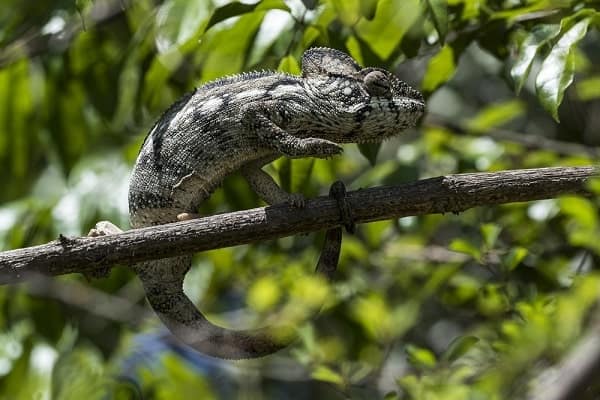
The Oustalet’s Chameleon, also known as the Malagasy Giant Chameleon, is the longest species of Chameleon in the world. As their second common name suggests, they’re native to Madagascar, but there are also introduced populations in Kenya.
They can reach up to about 27 inches in length, so the Parson’s Chameleon remains a close runner up.
They’re usually drab colors of brown or gray but occasionally display bright reds and greens. Like Veiled Chameleons, male Oustalet’s Chameleons have a prominent casque on their head.
This species is recommended for expert chameleon keepers ONLY, likely due to its large size and large enclosure requirements. Another factor is that many available animals are wild-caught imports that bring a heavy load of parasitic hitchhikers.
This species has an average lifespan of 5-8 years.
A single adult Oustalet’s Chameleon requires a mesh enclosure that’s at least 3′ x 3′ x 4′, preferably outdoors. The basking temperature should be 90-92°F, and the humidity should be maintained at about 70%.
If the humidity falls lower than that, give your Oustalet’s Chameleon at least one shower per week.
| Species Summary | |
|---|---|
| Scientific Name | Furcifer oustaleti |
| Common Name | Oustalet’s Chameleon, Malagasy Giant Chameleon |
| Lifespan | 5-8 years |
| Size | 27 inches |
| Price | $60-$150 |
| Enclosure Size | Minimum 3′ x 3′ x 4′ |
| Skill Level Required | Advanced |
8. Helmeted Chameleon
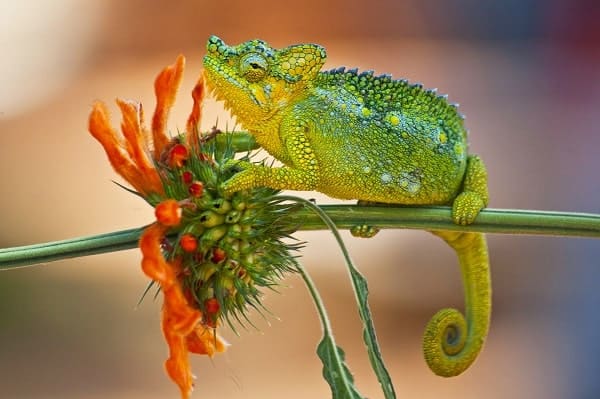
The Helmeted Chameleon is another species that should only be considered by advanced keepers because most animals in captivity are wild-caught imports with high stress levels and parasite loads. They’re native to Eastern Africa.
Prices seem to range from $80 to $100. If you dig deep in popular online chameleon communities, you may be able to find dedicated keepers who have had success breeding the species.
Helmeted Chameleons grow up to 10 inches in length.
Males and females both have a casque, a horny protrudance on the nose, and serrated back and throat crests. Their color can range from almost black to lime green or golden-yellow, depending on the time of day.
Their care is quite similar to Jackson’s Chameleons, but even more advanced.
They require a night-time temperature drop to you at least 50°F, preferably lower. During the daytime, Helmeted Chameleons prefer a basking temperature of 80-85°F and humidity at 40-55%.
| Species Summary | |
|---|---|
| Scientific Name | Trioceros hoehnelli |
| Common Name | Helmeted Chameleon |
| Lifespan | N/A |
| Size | 10 inches |
| Price | $80-$100 |
| Enclosure Size | 2′ W x 2′ L x 3′ T |
| Skill Level Required | Advanced |
9. Meller’s Chameleon
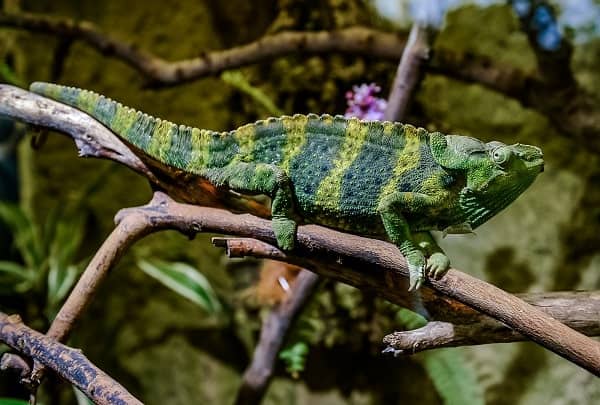
The Meller’s Chameleon is also known as the Giant One-Horned Chameleon. It’s the largest species found on the African mainland, outside of Madagascar, and it can grow up to about 24 inches long.
Males are larger than females and have bigger crests on their head and back. They have smaller heads and longer bodies than typical chameleons. Their tail is also noticeably shorter.
Overall, Meller’s Chameleons are usually dark green with white stripes and brown, yellow, and black bands and spots. While they’re darkly-colored, the hues offer interesting contrast and patterns.
Yet again, this species is not yet commonly bred in captivity. Wild-caught imports may be purchased for around $150.
One desirable trait of this species is its long lifespan of 10-12 years.
Meller’s Chameleons require an enclosure that’s at least 3’ x 3’ x 6’ because they’re an extremely active and territorial species. The basking spot should be 90-92°F during the day, and they require a high humidity level of 50-90% to thrive.
| Species Summary | |
|---|---|
| Scientific Name | Trioceros melleri |
| Common Name | Meller’s Chameleon, Giant One-Horned Chameleon |
| Lifespan | 10-12 years |
| Size | 24 inches |
| Price | $150 |
| Enclosure Size | Minimum 3’ x 3’ x 6’ |
| Skill Level Required | Intermediate |
10. Spiny Chameleon
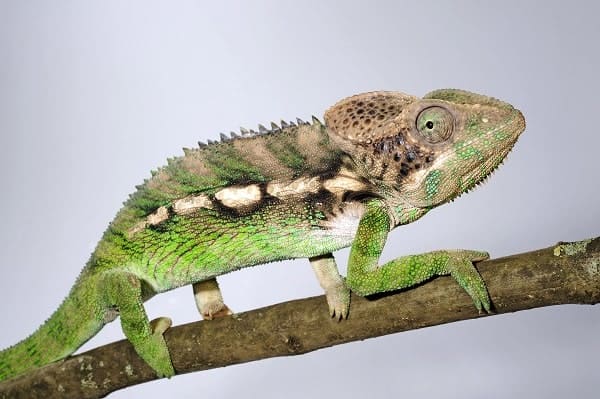
The Spiny Chameleon is a Madagascan species that also goes by the names of Warty Chameleon and Crocodile Chameleon, named after the spiky crests along the animal’s body.
This large species displays significant sexual dimorphism, with females reaching 8 inches and males reaching 22 inches.
They have a casque and spiny ridges along their face, sides, and back. They’re typically grey or brown with white streaks. Males have tinges of green, while females tend to be paler.
If cared for properly, Spiny Chameleons can live for 3 to 10 years. Imported animals cost $60-$100.
Due to their size, Spiny Chameleons require an enclosure that’s at least 2’ x 2’ x 4’. Their basking spot needs to be 90-95°F, and they prefer humidity in the 60-80% range.
Spiny Chameleons are another species that drinks a lot of water, so they require frequent misting or showering to thrive in captivity.
| Species Summary | |
|---|---|
| Scientific Name | Furcifer verrucosus |
| Common Name | Spiny Chameleon, Warty Chameleon, Crocodile Chameleon |
| Lifespan | 3-10 years |
| Size: | Females: 8 inches, Males: 22 inches |
| Price | $60-$100 |
| Enclosure Size | Minimum 2’ x 2’ x 4’ |
| Skill Level Required | Beginner |
11. Senegal Chameleon
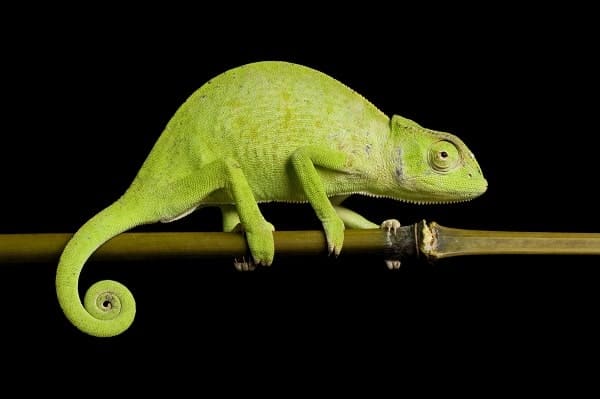
The Senegal Chameleon is one of few chameleon species that thrive in Africa’s more arid environments, although it’s still considered moist savanna.
They only grow to be 7 to 12 inches long, and their body is olive-brown or lime green with speckles of darker coloration.
Unlike many other distinguished species, Senegal Chameleons have no horns, crests, or casques. They’re a pretty “plain” looking chameleon.
Imported animals typically cost less than $50, making them one of the most affordable species, but this doesn’t necessarily reflect on their popularity or level of care required.
Provided with the proper husbandry, Senegal Chameleons have a relatively short-lived lifespan of 3-5 years.
Aim to reach a temperature of 85°F in the basking spot and 60-90% relative humidity in the habitat.
Being so modestly sized, they only require an enclosure that’s 1.5’ x 1.5’ x 2’.
| Species Summary | |
|---|---|
| Scientific Name | Chamaeleo senegalensis |
| Common Name | Senegal Chameleon |
| Lifespan | 3-5 years |
| Size | 7-12 inches |
| Price | <$50 |
| Enclosure Size | Minimum 1.5’ x 1.5’ x 2’ |
| Skill Level Required | Intermediate |
12. O’Shaughnessy’s Chameleon
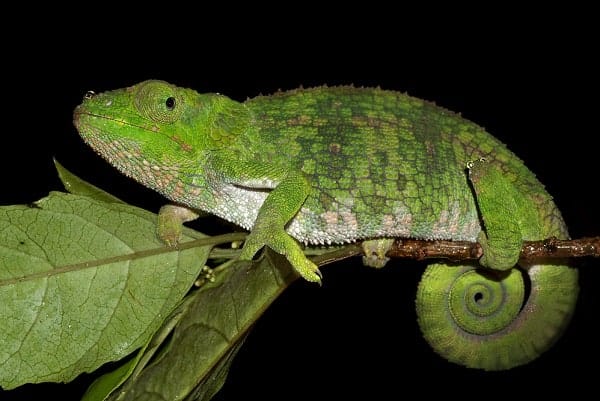
The O’Shaughnessy’s Chameleon is a medium-sized chameleon native to Madagascar. It was named after British poet and herpetologist Arthur O’Shaughnessy.
They grow to be 9 to 16 inches long, with a body shape similar to their close cousin, the Parson’s Chameleon. Males have a short, hard portrudence on their nose, reminiscent of a horn nub.
The coloration of this species is rather unique. The upper half of their head and shoulders are a drab tannish-brown, like dead leaves. This dull color is sharply contrasted by their green eyes and body and blue throat.
Keepers that have experience with this species note that they are pretty lazy and inactive, often picking their basking spot in the morning and remaining there for the entire day.
Imported animals fetch a pretty penny, usually priced at over $500.
Thanks to their overall lack of energy, a smaller adult O’Shaughnessy’s Chameleon could comfortably live in an 0.5 x 0.5 x 3′ mesh enclosure.
This species requires exceptionally high humidity, above 70%, and lots of surface water droplets to thrive. The basking spot can be kept at 85-88°F. Overall, their care is very similar to the Parson’s Chameleon.
| Species Summary | |
|---|---|
| Scientific Name | Calumma oshaughnessyi |
| Common Name | O’Shaughnessy’s Chameleon |
| Lifespan | 6-12 years |
| Size | 9-16 inches |
| Price | $500+ |
| Enclosure Size | 0.5 x 0.5 x 3′ mesh enclosure |
| Skill Level Required | Intermediate |
13. Cuban False Chameleon
While the Cuban False Chameleon is not a true chameleon, we felt it deserved an honorable mention in this list.
This interesting lizard earned its spot because of its unique chameleon-like anatomy, undemanding husbandry requirements, and overall suitability for beginner chameleon keepers and veteran reptile hobbyists, alike.
Cuban False Chameleons grow to be 6-9 inches long, with a body shape similar to their Anole cousins – but with a few ‘chameleony’ twists…
They have a small casque-like structure on the top of their head and a spiky beard-like dewlap. Their dull gray-brown color helps them to camouflage against branches and tree trunks.
Cuban False Chameleons can live in a modest 1.5′ x 2′ x 1.5′ enclosure with a 90°F basking spot and 70% humidity.
Like chameleons, they obtain water from droplets off leaves and the sides of the enclosure, so a planted habitat is ideal.
While they will eat most types of insects, it’s best to supplement their diet with snails, since that’s their primary food source in the wild.
| Species Summary | |
|---|---|
| Scientific Name | Anolis barbatus |
| Common Name | Cuban False Chameleon |
| Lifespan | 3-6 years |
| Size | 6-9 inches |
| Price | $150-$200 |
| Enclosure Size | 1.5′ x 2′ x 1.5′ |
| Skill Level Required | Intermediate |
